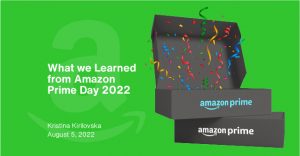Amazon Listing Images Guide & Best Practices for 2022

Having the right images that comply with Amazon requirements while being persuasive is crucial for boosting customer engagement and preserving high listing positions. Yet, with the increased number of product listings and ever fiercer competition, it is more challenging for sellers to qualify for the top-selling listing positions.
When differentiating your products, a high-quality product image is everything! A recent study by Field Agent shows that over 80% of US online shoppers find product images to be “very” and “extremely” influential in their online purchasing decisions.
To keep up with the competition today, Amazon sellers must feature high-quality products and lifestyle imagery that encourage conversion by creating a sense of confidence in customers’ purchasing decisions.
In this post, we will look at Amazon Product Image Requirements and share some tips and examples of the best Amazon practices in 2022. Below is a list of topics we will cover.
- Amazon Technical Requirements
- Amazon Main Image Tips and Guidelines
- Amazon Secondary Images Tips and Guidelines
- Amazon best practices for 2022
- Lifestyle images
- Infographics
- Comparison charts
- Product dimension images
- Before and After images
- Product installation images
So, let’s dive in!

Amazon Technical Requirements
When you add product images on Amazon, they must also meet certain technical specifications. Files that don’t meet these technical specifications and Amazon image requirements either won’t be uploaded or may be removed after upload. Therefore, it is essential to always work in compliance with the Amazon requirements:
– Amazon accepts different file formats for images such as JPEG (.jpg/.jpeg), PNG (.png), TIFF (.tif/.tiff), and GIF (.gif). However, JPEG is recommended.
– All images should be at least 1000px, and preferably 2560px, in width so that customers can zoom in on the details of the product image.
– The maximum dimension for a product image is limited to 10000 pixels on the longest side. The images may not exceed 10,000 pixels.
– The color mode should be RGB or CMYK. Amazon prefers RGB because CMYK color mode is often shown tonal variations.
– File names must consist of the product identifier (Amazon ASIN, JAN, EAN, 13-digit ISBN or UPC) followed by a period and the appropriate file extension (Example: B000123456.jpg or 0237425673485.tif)
– Image resolution should be at least 72 dpi. But it is recommended to have 300 dpi for high-quality images.
– The maximum file size allowed for each product image is 10MB.

Amazon Main Image Tips and Guidelines
The main image is arguably the most important part of your whole listing as it directly impacts the listing CTR. It should immediately display Who the brand is, What the product is, Which variety and What amount the consumer would purchase.
– The main image must be the professional photograph or the cover art of the product sold.
– The main image should always have just the product in focus, occupying at least 85% of the frame.
– The main image must have a pure white background, Amazon requests (RGB color values 255, 255, 255)
– The image must show the entire product. The images must not be cut or missed by the borders of the image frame, except for jewelry.
– Text, logos, borders, color blocks, watermarks, or other graphics placed over the product or in the background may not be used in the main image.
– The image must contain only a single view of the product.
– Props or accessories that are not included with the item should not be used.
– Apparel must be photographed on a human model, not a mannequin.
– Multi-pack apparel items and accessories must be photographed flat and off of the model.
– Kids and baby clothing must be photographed flat and off of the model.
– Shoes must be photographed at an angle of 45 degrees facing the left. The image must show a single shoe.
– Books, music, and video/DVD main images should be displayed as the front cover art and fill 100% of the frame.
– Products must be shown outside of their packaging unless the packaging is considered an important product feature.

Amazon Secondary Images Tips and Guidelines
There are also some Amazon image guidelines for additional images:
– Show off the product by including multiple angles and viewpoints. Prioritize detail in your product images to avoid misleading customers.
– Utilize high-quality images showing the product in action. Avoid images that are blurry or have sharp edges.
– Use of logo or trademark on images is allowed only for brand owners
– Additional images must not include Amazon logos or trademarks.
– Files must be 1600 pixels or greater on the longest side to provide the best zoom experience on the Amazon product page.

Amazon best practices for 2022

Lifestyle images
Great lifestyle photos paint pictures for the customer and help them imagine themselves using the product in the home or workspace. Thus, featuring lifestyle images showing products in action can answer many of the product-related customers’ questions and reassure their purchasing decision.
Based on our experience, the best lifestyle images are those that:
– Utilize high-quality images
– Show real people with non-forced smiles, enjoying the product
– Show human models interacting with the product. This is especially important for personal items
– Chose a background in context to the product
– Chose a clean, modern, aesthetically pleasing background that puts the product in focus
– Promote diversity, use models from different races and ethnicity
– Chose models within the same age group as the targeted audience
If you are not adept with product photography or lack editing skills, we recommend hiring a design agency to do professional photography or create high-quality lifestyle images for you. Remember, images are the first thing shoppers see when opening your listing. Poor-quality images can discourage them from moving forward with the purchase, which will only benefit your competitors.

Infographics
The idea behind secondary images is not just to look good but to be informative enough to persuade the shopper to make the purchase. Every secondary image should be approached individually, so each has a purpose and describes a specific product feature or benefit. Adding infographics to your listing can dramatically improve traffic and Amazon sales since they tend to generate emotional responses among the audience and retain their interest. A good infographic has:
– Short yet descriptive title and subheadings
– Appropriate color scheme matching the overal brand aesthetics
– Clear and readable font, visible from smaller screens (mobile/tablet)
– Incudes shots from multiple product angles
– Uses close-ups to prioritize specific product details
– Includes short descriptions under each product feature. It applies to more complex products
– Points out parts integrated with the product. It can be done by utilizing 3D renders.
For sellers with limited budgets and a lack of quality product images, using 3D renders can do a great job in terms of getting realistic shots. Fliprise team has extensive experience working with 3D renders, delivering creative solutions to various Amazon brands.

Comparison charts
Comparison charts are essential in product listing images since they allow shoppers to compare product features with other brands selling the same product on the Amazon platform. For sellers, it is an excellent way to pinpoint specific product features and showcase their advantages over competitors. It is a great tool that helps sellers wrap up the sales before customers move to the following listing. Comparison charts should include all the information that differentiates the product from the others, such as:
– Unique selling point
– Specific product benefits
– Price and quantity
– Product guarantee
– Product lifetime
– Product certifications
Pro tip: Use your name and brand logo for better recognition. However, avoid naming your competitors as it is against the Amazon rules. Instead, refer to them as “Others,” “Other Competitors,” Other Brands,” or “Competitor 1, Competitor 2, etc.”
Another way to take advantage of comparison charts is through the Enhanced Brand Content or so-called A+ section. We suggest you use the module under the Standard Comparison Chart available in the A+ section. Although this module does not allow comparing competitors’ products, it is an excellent tool for displaying other products from your catalogs, such as complementary products and color variations.

Product dimension images
To help shoppers navigate the product they are searching for, you should add dimension images to your listings. Product dimensions are essential for product categories where the size and dimensions of the product matter and can make a significant difference to their purchasing decision. The best practice for this type of image is placing the product in a central position and adding dimensions in both US and EU metrics.
Pro tip: Use objects such as coins, i-phones, or human models for comparison to better represent product size and dimensions.

Before and After images
There is no better way to encourage people to take action than by showing them evidence.
One reason “before and after” photos work so well is that they are relatable and create connections. For shoppers, it is much easier to visualize themselves with a product or service when they can identify with the “before” and then see the “after” result.
Pro tip: Always use genuine “before and after” photos. Avoid using scams or photoshopped images since it can backfire in the long run.

Product installation images (How to images)
Shoppers value brands that care about them and work hard to ensure their positive buying experience. Thus, part of your job is to teach customers how to use or assemble products. The best way to do so is through step-by-step guides backed with simple text, images, or graphics for better visualization.
Conclusion
Good imagery is worth more than anything in today’s technology-driven world, primarily e-commerce. Humans are highly visual creatures, and when it comes to selling online, visual content is key to getting their attention. In this post, we shared helpful information that can significantly impact how you create your images and differentiate your listings from the crowd. Investing in high-quality images that are persuasive, engaging, and in line with Amazon image requirements will contribute to the success of your Amazon store and business as a whole.
More to Explore

Why
Fliprise
Working with us means a distinctive and personal approach to your business. We are able to identify growth opportunities and bring you a step closer to your goals. We believe in open communication, transparency, and straightforwardness, and most of all - success.
Learn More

